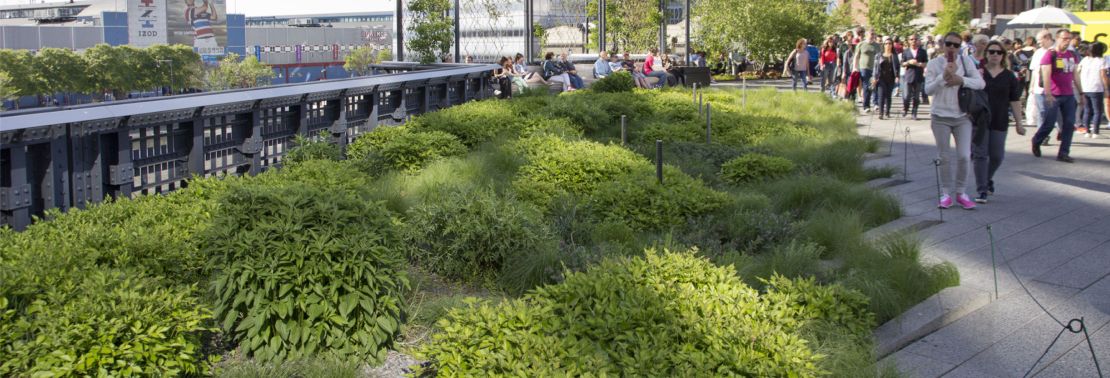A Comparison of the Three Phases of the High Line, New York City: A Landscape Architect and Photographer’s Perspective
“A Comparison of the Three Phases of the High Line, New York City: A Landscape Architect and Photographer’s Perspective” compares Phase One with Phase Two, and describes what is proposed for Phase Three. Design features to be reviewed include the walk system, seat furnishings, plantings, signage and graphics, water feature and drinking fountains, public art, lighting, maintenance and irrigation, and Phase 3. The author also offers suggestions on economic impacts, restrictions and user activities, sustainability, and studies/research.
Originally, due to the length and photo essay nature of the contribution, the series was presented approximately every few weeks in 14 parts between 2013 and 2015; to ensure background information, the Series Introduction is repeated on all.
Part 1 – Walk System
By Steven L. Cantor, Landscape Architect – Originally Posted December 19, 2013
All Photos © Steven L. Cantor
Series Introduction
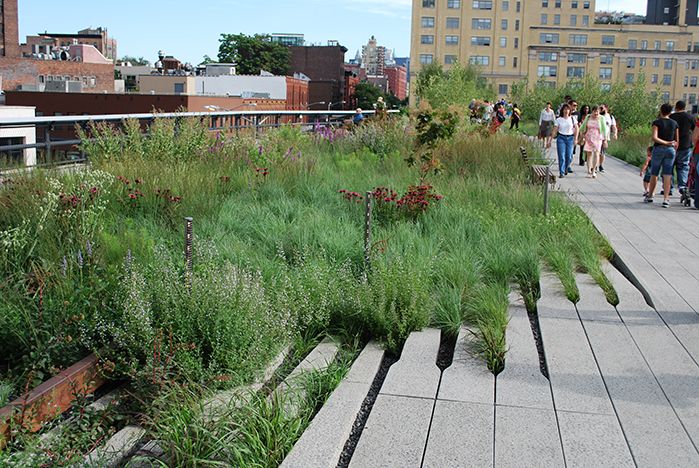
Phase One High Line on July 15, 2009.
Designed by landscape architect James Corner of Field Operations, architect Ricardo Scofidio of Diller Scofidio + Renfro with planting design by Piet Oudolf, the High Line, the remarkable linear park built on an abandoned railroad viaduct in New York City, has been enormously popular.
The design team anticipated how well green roof technology would function and adapt to the viaduct since it could handle at once the huge weight of several fully-loaded trains carrying heavy tonnage. As an intensive green roof, it has very few structural load limits which would curtail use. At peak use times there can be lines of pedestrians waiting to enter with as many as 20,000 visitors per day on weekends.[1]
The High Line has won numerous awards, and in particular several as a green roof, for example, in 2013 and 2010 from the American Society of Landscape Architects, Green Roofs for Healthy Cities in 2011, and in 2010 from the International Green Roof Association. This is a rare public project in which the success of the initial phase contributed to a high level of funding for subsequent phases.
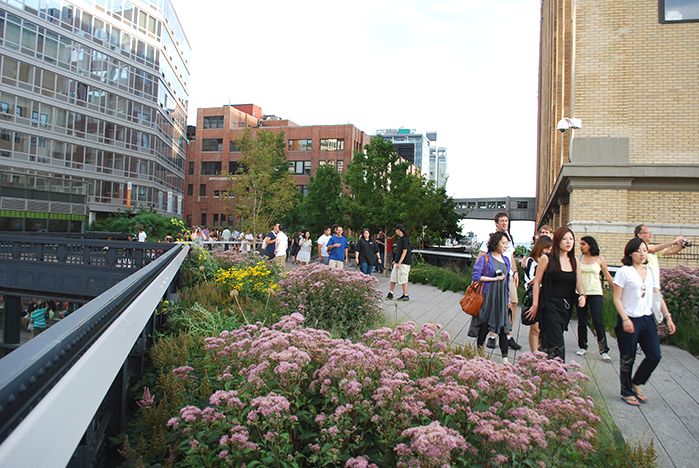
7.16.11.
The High Line has benefited from intense scrutiny as a result of lectures in which the designers were questioned; public hearings, media critiques in newspapers, journals, and blogs; lobbying from specific organizations, such as the Rainforest Coalition; and comments from city government and other public officials.
Improvements or adjustments were implemented to some design elements of the first phase, and significant modifications were done in the second phase. Are these changes aesthetic, appropriate and ethical, and are they consistent with the goals of sustainability? Is the High Line a sustainable design?
Part 1: Walk System Discussion
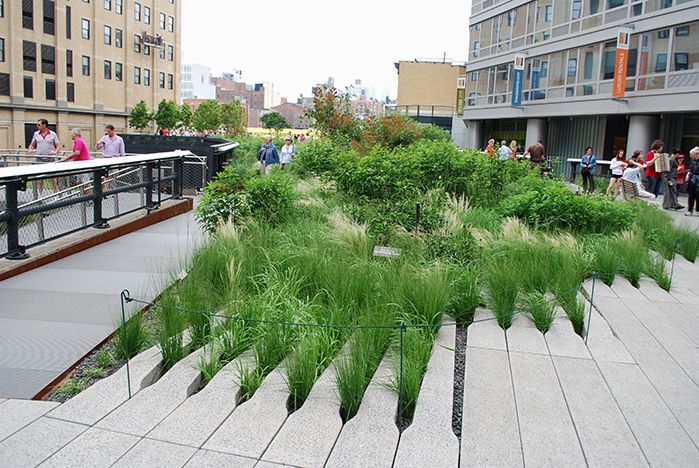
6.12.10.
When the first phase of the High Line opened, there were some initial complaints about potential tripping hazards created by the subtle way the concrete planks curve upward to connect with the railroad tracks and define planting beds. The integrated nature of the pavements with the plantings made it more difficult for pedestrians to perceive a clear-cut edge where the pavement would end and the planting beds begin.
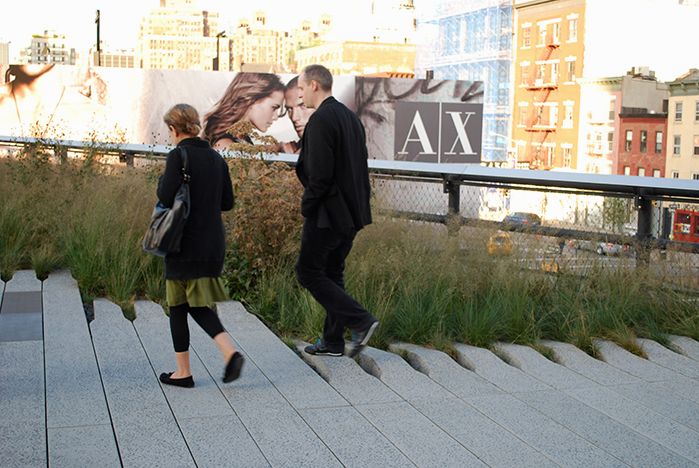
Phase One, 9.25.09.
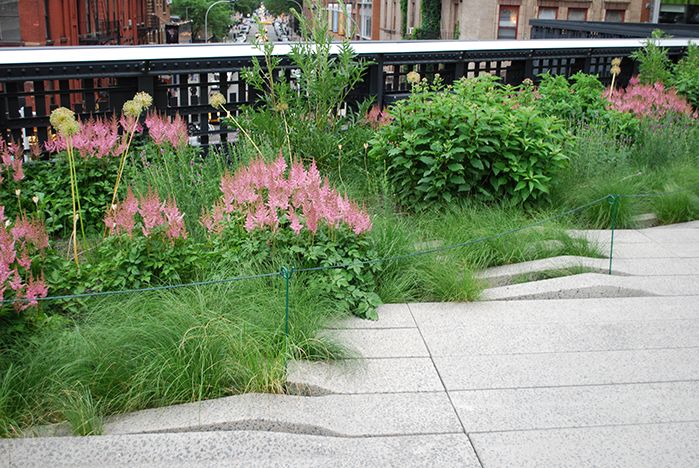
6.16.11.
Since the second phase runs parallel to the street grid, most of the pavement planks are set parallel to and not at an angle to the direction in which pedestrians are walking. As a result, there is less likelihood for some of the potential tripping hazards that occurred in the first phase.
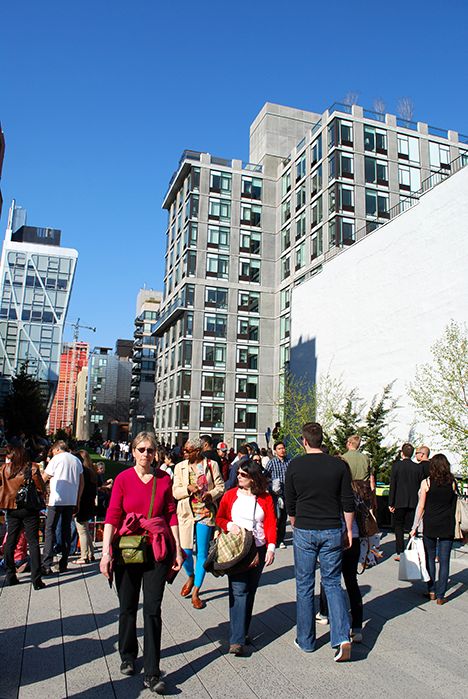
Phase Two, 4.27.13.
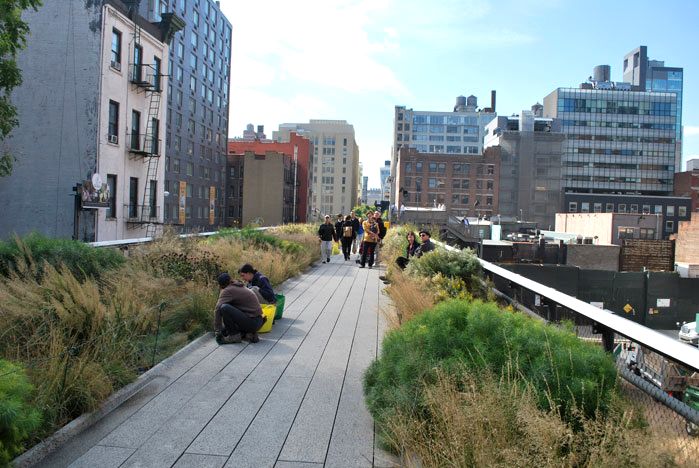
10.13.13.
To correct the problem, in one location in the first phase, shiny metal strips, almost like nosings on steps, were fastened to the top of the concrete plank adjacent to a planting bed to create a highly visible edge. A knee-high, dark green cable was installed in many locations throughout both phases of work for the dual purpose of keeping people from walking into the planting beds and to subtly emphasize the edge so that people would not trip.
My sense is that the intensive use of the park results in the full use of the plank pavement across its entire width. Since some pedestrians are pushed to walk right at the edge of the pavement, there is a need for a better separation of functions.
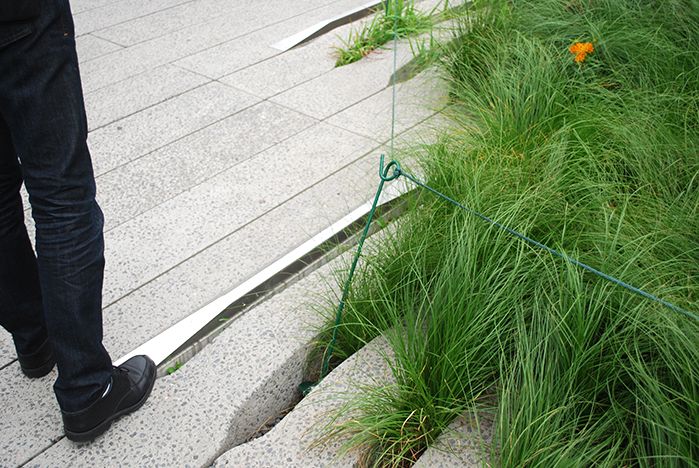
6.16.11.
A knee high green cable has been installed throughout the park to prevent people from walking into the planting beds and to emphasize the edge so as to avoid tripping hazards. The metal strips applied directly on the pavement are installed in a particularly vulnerable location as seen in the above photo.
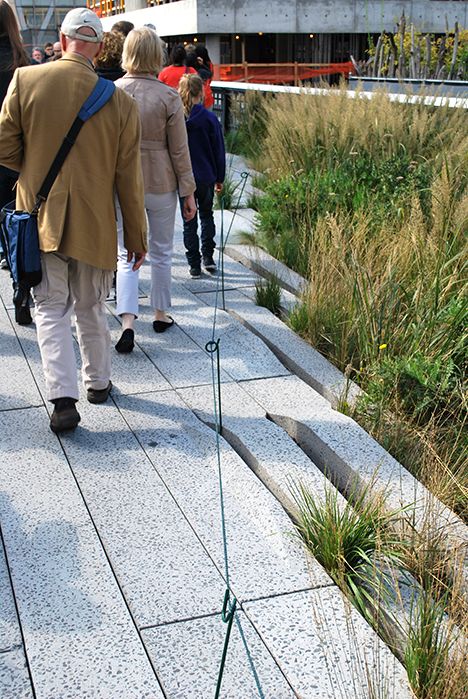
Walking close to the edge; 10.13.13.
The use of this cable, although relatively unobtrusive, is still noticeable and at times, distracting, particular when it hovers over the narrow “tines” in areas of minimal planting. Its height is perfect for babies, and I’ve seen several toddlers walking along the edge while holding onto the cable, while parents watch with amusement.
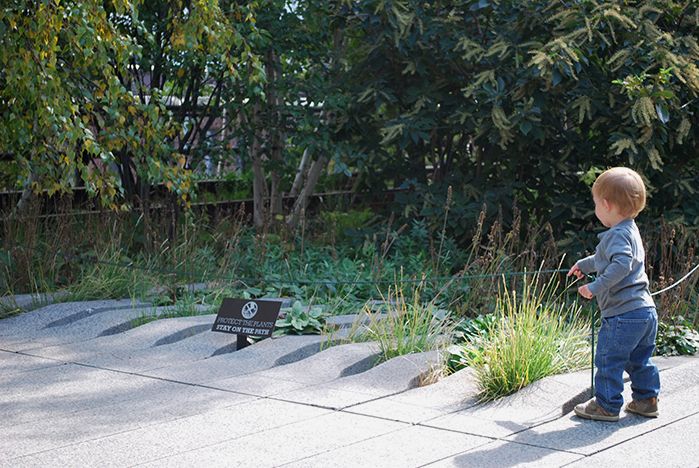
10.14.13.
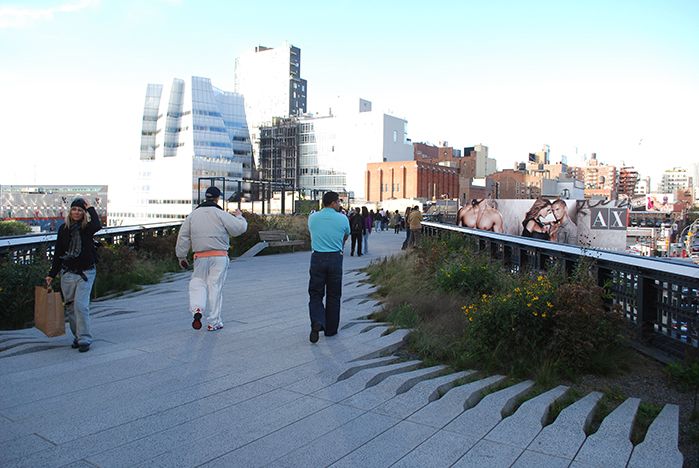
9.25.09.
It’s not always clear why some areas that appear prone to potential tripping or damaging of plant materials have no cable, and some naturally protected areas nevertheless have the cable installed. Since the first phase opened, over time I’ve observed more and more cable being incorporated so that it’s practically continuous throughout the entire design.

6.11.10.
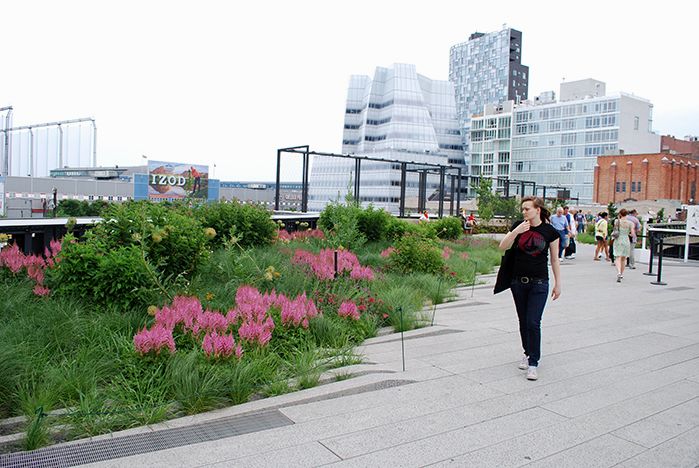
6.12.10.
There are a few areas of the High Line, at gathering points and intersections, for example, where the plank pavement has tight joints without the tine treatment.
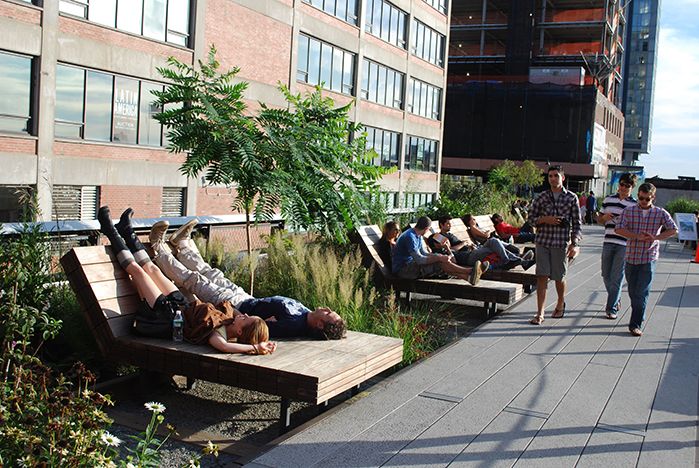
Phase One, 9.25.09.
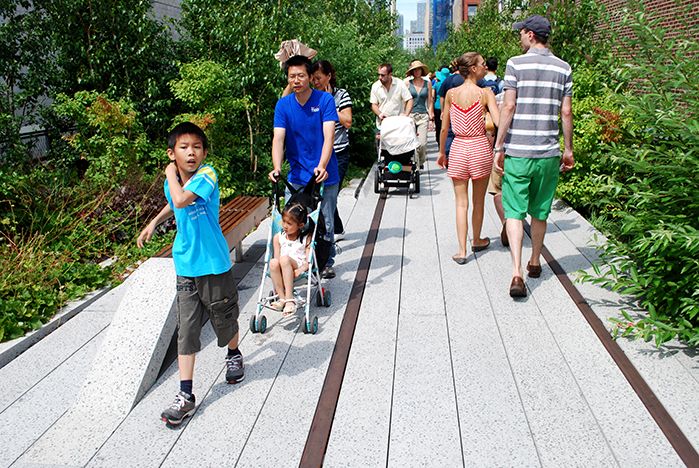
6.19.11.
One location near W. 14th Street (in the first phase) incorporates the railroad tracks directly into the pavement where people are walking, and a central planter has a crisp vertical edge of Cortens steel.
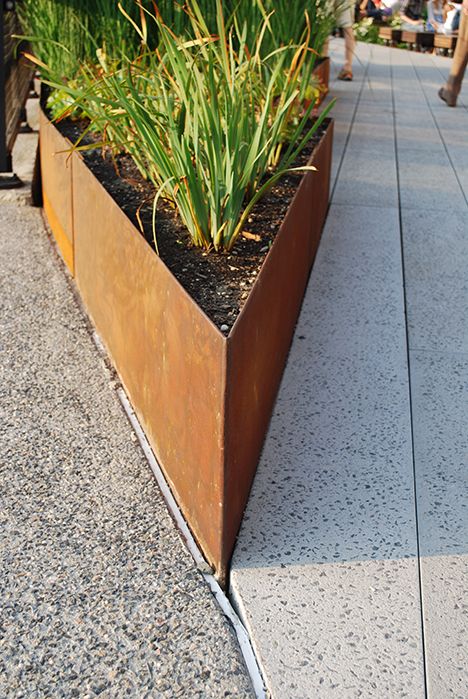
8.03.09.
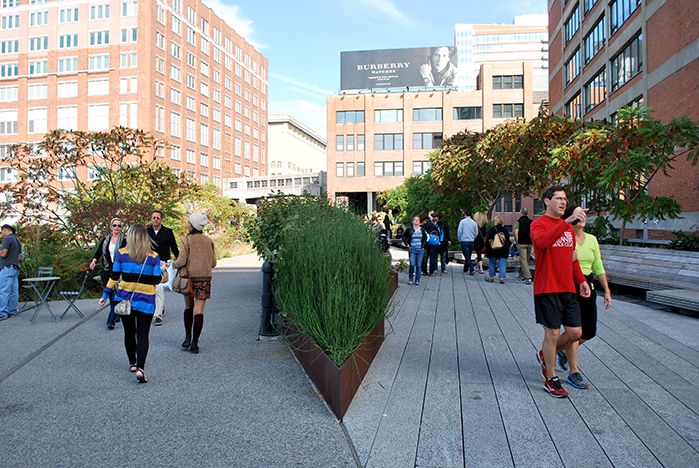
10.14.13.
At the north end of the High Line near West 30th Street, the pavement system curves in a tight arrangement without the tines of the plank treatment. These two areas make effective contrasts.
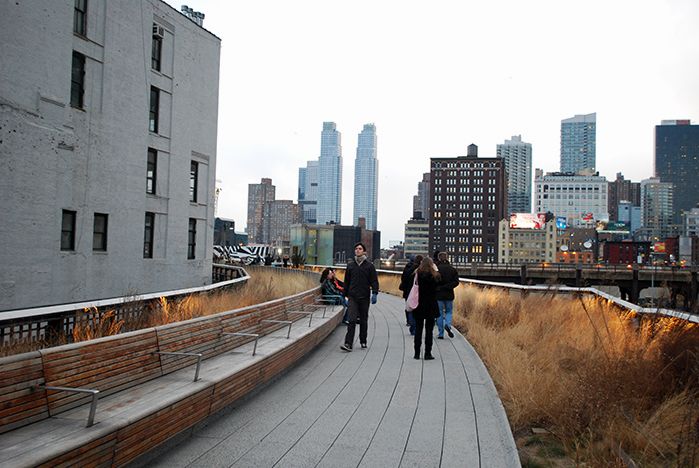
Phase Two, 2.18.12.
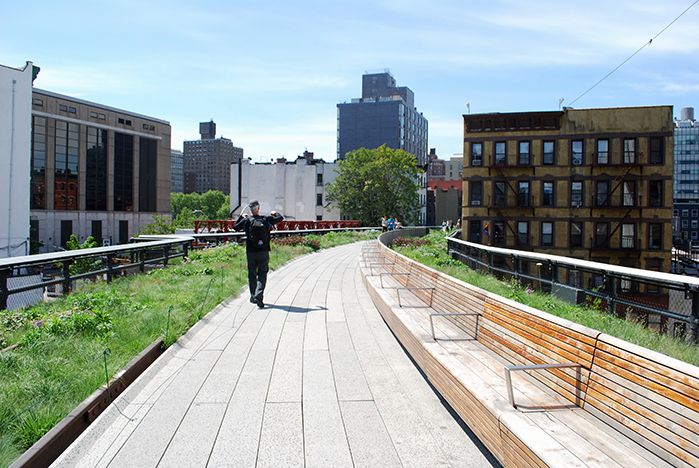
5.10.12.
Additional High Line Walk System Photos
That’s it for now. I hope that these different sections of text and images of the High Line will generate discussion.
Come back next week for Part 2 of “A Comparison of the Three Phases of the High Line, New York City: A Landscape Architect and Photographer’s Perspective” where I’ll discuss Seat Furnishings.
Steven L. Cantor
Photos © Steven L. Cantor are available for individual purchase.
Cumulative 14-part “A Comparison of the Three Phases of the High Line, New York City: A Landscape Architect and Photographer’s Perspective” Series End-notes
1. Ulam, Alex. “Back on Track,” Landscape Architecture Magazine. Volume 99, No. 10, October, 2009, p. 97.
2. http://www.thehighline.org/news/2012/01/24/major-milestone-for-the-high-line-at-the-rail-yards
Publisher’s Note:
See Steven L. Cantor’s ENTIRE 14-part “A Comparison of the Three Phases of the High Line, New York City: A Landscape Architect and Photographer’s Perspective” Series.
Steven L. Cantor, Landscape Architect

Photo by Thomas Riis.
Steven L. Cantor is a registered Landscape Architect in New York and Georgia with a Master’s degree in Landscape Architecture from the University of Massachusetts, Amherst. He first became interested in landscape architecture while earning a BA at Columbia College (NYC) as a music major. He was a professor at the School of Environmental Design, University of Georgia, Athens, teaching a range of courses in design and construction in both the undergraduate and graduate programs. During a period when he earned a Master’s Degree in Piano in accompanying, he was also a visiting professor at the College of Environmental Design at the University of Colorado, Boulder. He has also taught periodically at the New York Botanical Garden (Bronx) and was a visiting professor at Anhalt University, Bernberg, Germany.
He has worked for over three decades in private practice with firms in Atlanta, GA and New York City, NY, on a diverse range of private development and public works projects throughout the eastern United States: parks, streetscapes, historic preservation applications, residential estates, public housing, industrial parks, environmental impact assessment, parkways, cemeteries, roof gardens, institutions, playgrounds, and many others.
Steven has written widely about landscape architecture practice, including two books that survey projects: Innovative Design Solutions in Landscape Architecture and Contemporary Trends in Landscape Architecture (Van Nostrand Reinhold, John Wiley & Sons, 1997). His book Green Roofs in Sustainable Landscape Design (WW Norton, 2008), provides definitions of the types of green roofs and sustainable design, studies European models, and focuses on detailed case studies of diverse green roof projects throughout North America. In 2010 the green roofs book was one of thirty-five nominees for the 11th annual literature award by the international membership of The Council on Botanical & Horticultural Libraries for its “outstanding contribution to the literature of horticulture or botany.”
Steven’s most recent book is Professional and Practical Considerations for Landscape Design (Oxford University Press, 2020) where he explains the field of landscape architecture, outlining with authority how to turn drawings of designs into creative, purposeful, and striking landscapes and landforms in today’s world.
He has been a regular attendee and contributor at various ASLA, green roofs and other conferences in landscape architecture topics.
In recent years Steven has had more time for music activities, as a solo pianist and accompanist. In 2011 he performed a solo piano program at the Winter Rhythms festival at Urban Stages Theater. He’s a regular performer at musicales hosted in Chelsea and other settings in Manhattan. On August 25, 2013, Leonard Bernstein’s birthday, he performed with Stephen Kennedy Murphy a program of excerpts from the composer’s MASS and Anniversaries.
Steven joined the Greenroofs.com editorial team in December, 2013 as the Landscape Editor. In February, 2015 he completed his 14-part series “A Comparison of the Three Phases of the High Line, New York City: A Landscape Architect and Photographer’s Perspective.”
 Greenroofs.comConnecting the Planet + Living Architecture
Greenroofs.comConnecting the Planet + Living Architecture
